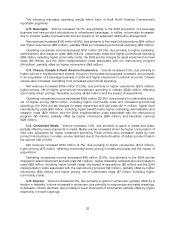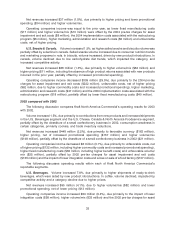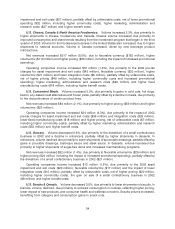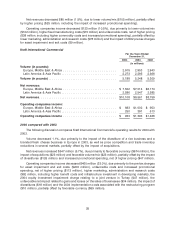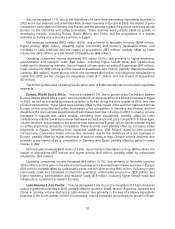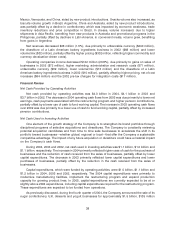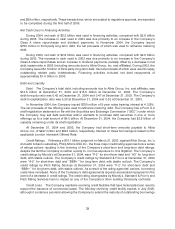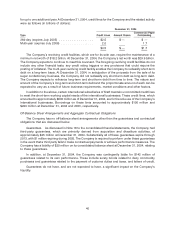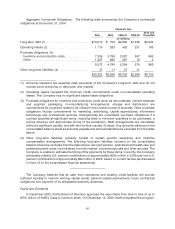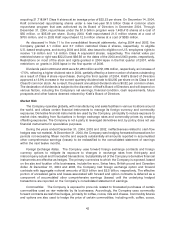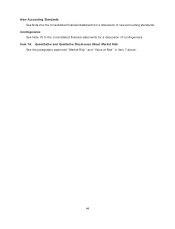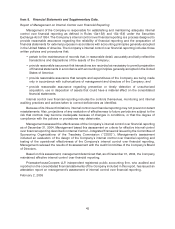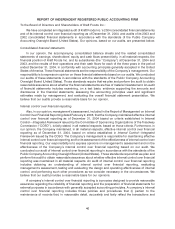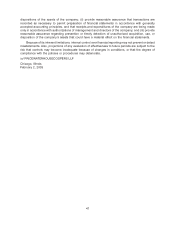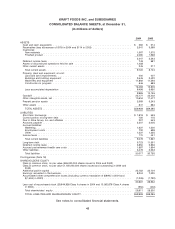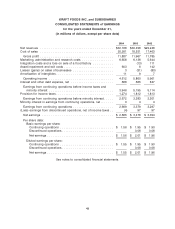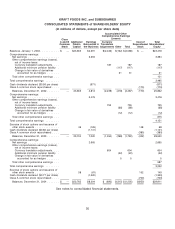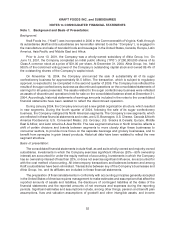Kraft 2004 Annual Report Download - page 43
Download and view the complete annual report
Please find page 43 of the 2004 Kraft annual report below. You can navigate through the pages in the report by either clicking on the pages listed below, or by using the keyword search tool below to find specific information within the annual report.acquiring 21,718,847 Class A shares at an average price of $32.23 per share. On December 14, 2004,
Kraft commenced repurchasing shares under a new two-year $1.5 billion Class A common stock
repurchase program that was authorized by its Board of Directors in December 2004. Through
December 31, 2004, repurchases under the $1.5 billion program were 1,408,413 shares at a cost of
$50 million, or $35.49 per share. During 2004, Kraft repurchased 21.5 million shares at a cost of
$700 million, and in 2003 Kraft repurchased 12.5 million shares at a cost of $380 million.
As discussed in Note 11 to the consolidated financial statements, during 2004 and 2003, the
Company granted 4.1 million and 3.7 million restricted Class A shares, respectively, to eligible
U.S.-based employees, and during 2004 and 2003, also issued to eligible non-U.S. employees rights to
receive 1.9 million and 1.6 million Class A equivalent shares, respectively. The market value per
restricted share or right was $32.23 and $36.56 on the dates of the 2004 and 2003 grants, respectively.
Restrictions on most of the stock and rights granted in 2004 lapse in the first quarter of 2007, while
restrictions on grants in 2003 lapse in the first quarter of 2006.
Dividends paid in 2004 and 2003 were $1,280 million and $1,089 million, respectively, an increase of
17.5%, reflecting a higher dividend rate in 2004, partially offset by a lower number of shares outstanding
as a result of Class A share repurchases. During the third quarter of 2004, Kraft’s Board of Directors
approved a 13.9% increase in the current quarterly dividend rate to $0.205 per share on its Class A and
Class B common stock. As a result, the present annualized dividend rate is $0.82 per common share.
The declaration of dividends is subject to the discretion of Kraft’s Board of Directors and will depend on
various factors, including the Company’s net earnings, financial condition, cash requirements, future
prospects and other factors deemed relevant by Kraft’s Board of Directors.
Market Risk
The Company operates globally, with manufacturing and sales facilities in various locations around
the world, and utilizes certain financial instruments to manage its foreign currency and commodity
exposures. Derivative financial instruments are used by the Company, principally to reduce exposure to
market risks resulting from fluctuations in foreign exchange rates and commodity prices by creating
offsetting exposures. The Company is not a party to leveraged derivatives and, by policy, does not use
financial instruments for speculative purposes.
During the years ended December 31, 2004, 2003 and 2002, ineffectiveness related to cash flow
hedges was not material. At December 31, 2004, the Company was hedging forecasted transactions for
periods not exceeding fifteen months and expects substantially all amounts reported in accumulated
other comprehensive earnings (losses) to be reclassified to the consolidated statement of earnings
within the next twelve months.
Foreign Exchange Rates. The Company uses forward foreign exchange contracts and foreign
currency options to mitigate its exposure to changes in exchange rates from third-party and
intercompany actual and forecasted transactions. Substantially all of the Company’s derivative financial
instruments are effective as hedges. The primary currencies to which the Company is exposed, based
on the size and location of its businesses, include the euro, Swiss franc, British pound and Canadian
dollar. At December 31, 2004 and 2003, the Company had foreign exchange option and forward
contracts with aggregate notional amounts of $2.9 billion and $2.5 billion, respectively. The effective
portion of unrealized gains and losses associated with forward and option contracts is deferred as a
component of accumulated other comprehensive earnings (losses) until the underlying hedged
transactions are reported on the Company’s consolidated statement of earnings.
Commodities. The Company is exposed to price risk related to forecasted purchases of certain
commodities used as raw materials by its businesses. Accordingly, the Company uses commodity
forward contracts as cash flow hedges, primarily for coffee, cocoa, milk and cheese. Commodity futures
and options are also used to hedge the price of certain commodities, including milk, coffee, cocoa,
42


